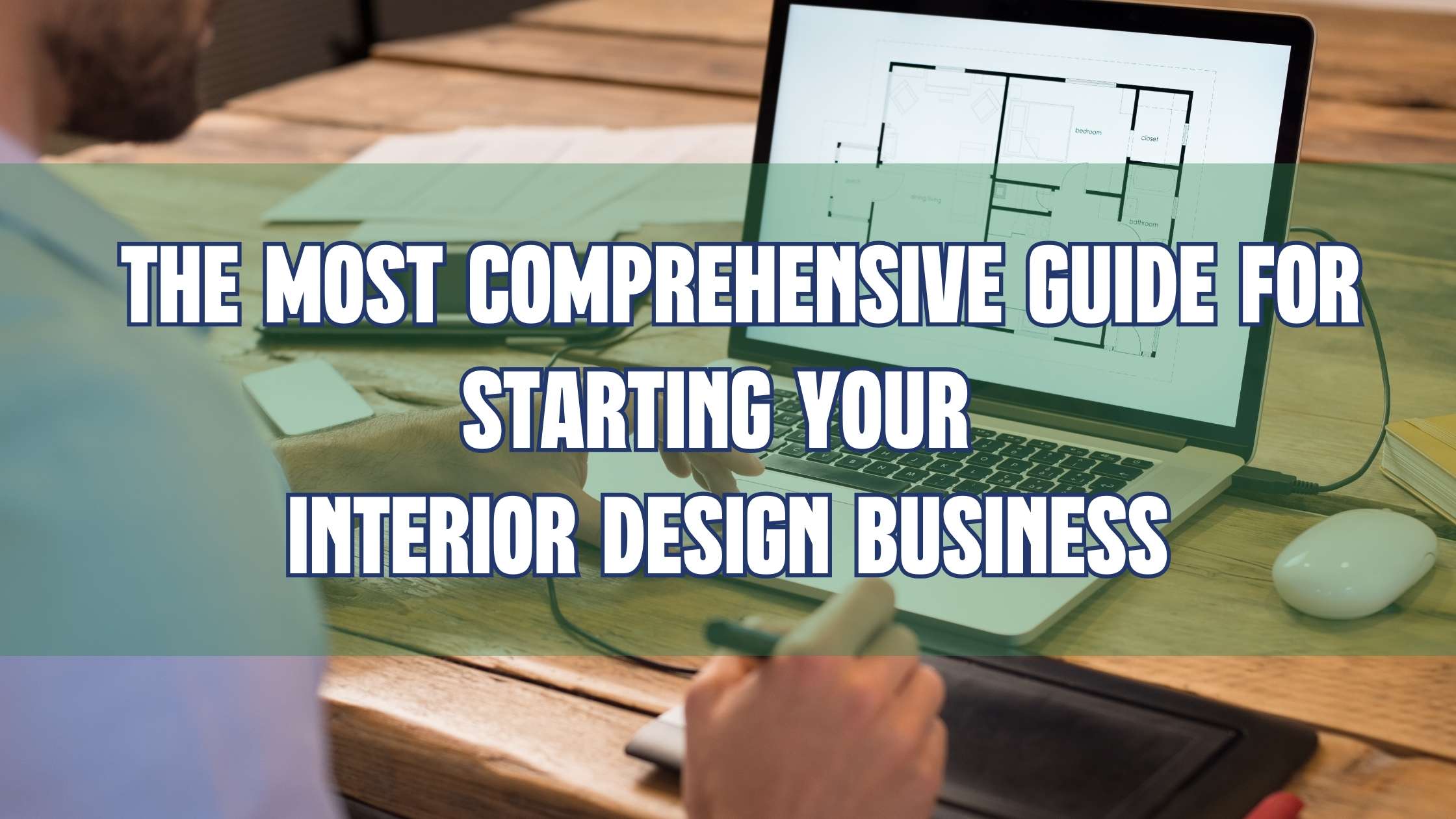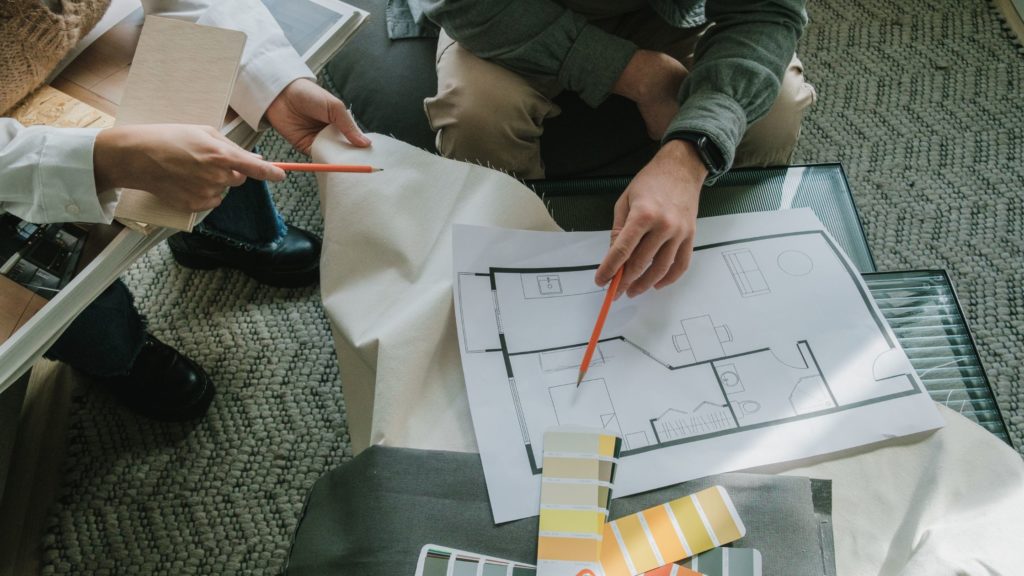
Embarking on the journey of starting your own interior design business can be both thrilling and daunting. However, with the expert guidance and support of an experienced interior design business coach, you can transform your dreams into a flourishing reality. This article serves as your comprehensive guide, offering invaluable insights and practical strategies to kickstart your interior design business. From crafting a compelling brand identity to mastering financial management, you’ll find all the essential steps to ensure your business’s success.
Define Your Brand and Services
Developing a business plan is a crucial step in starting any business, including an interior design business. A well-written and thorough business plan can help you outline your goals, identify potential challenges, and create a roadmap for success. In this section, we’ll go over the key components of a business plan and offer some tips for creating a plan that meets your needs and sets you up for success.
Identify Your Target Market: Define your ideal customer and determine their demographics, such as age, income, location, and style preferences. This will help you tailor your services and brand messaging to attract your ideal client.
Determine Your Unique Selling Proposition: What makes your design services stand out from your competitors? Perhaps you specialize in eco-friendly design or have a signature style that sets you apart. Clearly articulate your unique selling proposition in your branding and marketing materials.
Develop Your Brand Identity: Your brand identity encompasses your logo, color scheme, typography, and overall aesthetic. Your branding should reflect your style and unique selling proposition and be consistent across all your marketing channels.
Define Your Services: Determine the scope of your services, such as full-service design, consultation services, or e-design. Consider offering packages or tiers of services to cater to different budgets and needs.
Establish Your Pricing: Determine your pricing structure and rates for your services. Consider your expenses, experience level, and competition when setting your prices. Offer transparency in your pricing and clearly communicate your rates to potential clients.
Create a Mission Statement: Develop a mission statement that reflects your design philosophy, values, and goals. Your mission statement should guide your decision-making and communicate your brand’s vision to clients and stakeholders. Here’s a full guide by interior design business coach Eric Lee on how to write the perfect mission & vision statements.
By taking the time to define your brand and services, you can create a strong foundation for your interior design business and attract your ideal clients. Use your brand messaging and unique selling proposition to differentiate yourself in a competitive market, and develop a portfolio of work that showcases your expertise and style.
If you need help setting your brand’s core values, watch this comprehensive video on our youtube channel, that covers all the pillars of discovering your organization’s core values

Develop a Business Plan
Developing a business plan is a crucial step towards establishing a successful interior design business. It serves as a roadmap for your company, outlining your goals, strategies, and financial projections.
Executive Summary: This section is a concise summary of your entire business plan, highlighting your goals and the key points of your business.
Company Description: This section describes your interior design business in detail. It includes information such as the legal structure of your company, your mission statement, and a brief history of how you came up with the idea for your business.
Market Analysis: This section analyzes the current interior design industry and identifies your target market. It includes research on your competitors, market trends, and your unique selling proposition.
Services and Products: This section outlines the services and products that your interior design business will offer. It includes a detailed description of each service, the pricing structure, and how it will benefit your clients.
Marketing and Sales Strategies: This section details your marketing and sales strategies, including advertising, public relations, networking, and social media. It also includes a sales forecast and the methods you will use to measure the success of your marketing efforts.
Financial Projections: This section includes your projected income statement, balance sheet, and cash flow statement. It outlines your startup costs, expected revenue, and expenses for the first few years of your business.
Management Team: This section introduces your management team, including your experience and qualifications. It highlights your skills and how they will contribute to the success of your business.
Your business plan is a living document that should be reviewed and updated regularly. It can help you stay on track and make informed decisions as you grow your interior design business. Take the time to create a thorough and detailed plan that reflects your goals and strategies.

Set Up Your Business Structure and Legal Requirements
Before getting into setting the right legal structure for your interior design business. Watch this video to get a full overview of how much it costs to start an interior design business
Now that you’ve watched the video, let’s get right to it. Setting up the right legal structure for your interior design business is crucial to ensure its success and protect your personal assets. There are several types of business structures to choose from, including sole proprietorship, partnership, limited liability company (LLC), and corporation. Each structure has its own advantages and disadvantages, so it’s important to research and choose the one that suits your business needs and goals.
For most small interior design businesses, setting up an LLC is a popular choice. This type of business structure offers limited liability protection to the owners while still allowing for flexible management and tax benefits. To set up an LLC, you will need to file articles of organization with your state’s secretary of state and pay a fee. You will also need to obtain any necessary licenses and permits required by your state or local government.
In addition to setting up your business structure, it’s important to understand and comply with all legal requirements for your business. This includes registering for state and local taxes, obtaining any necessary business permits, and adhering to any industry-specific regulations. You may also want to consult with an attorney or accountant to ensure you are fully compliant with all legal requirements.
Taking the time to set up your business structure and comply with legal requirements may seem daunting, but it’s a crucial step in ensuring the long-term success of your interior design business.

Establish Your Online Presence
In today’s digital age, having a strong online presence is crucial for any business, including interior design. This includes creating a website, social media accounts, and listings on directories like Houzz and HomeAdvisor. Your website should showcase your portfolio, services, and contact information. Consider hiring a professional web designer or using website builders like Squarespace or Wix to create a visually appealing and user-friendly website.
In addition to creating a website, it’s important to establish a strong presence on social media platforms like Instagram and Pinterest. These platforms are visual and allow you to showcase your design skills, while also engaging with potential clients and industry professionals. Make sure to post regularly and use relevant hashtags to increase your visibility.
You can also consider listing your business on directories like Houzz and HomeAdvisor to increase your reach and attract potential clients who are searching for interior designers in their area.
Another way to establish your online presence and boost your business is by enrolling in an interior design course like the Designers Business Accelerator by award-winning interior designer and business coach, Eric Lee. This course provides valuable insights and strategies for starting and growing an interior design business, including establishing your brand, marketing your services, and managing your finances. By investing in your education and skills, you can enhance your credibility and attract more clients to your business.
In today’s digital age, having a strong online presence is crucial for any business, including interior design. This includes creating a website, social media accounts, and listings on directories like Houzz and HomeAdvisor. Your website should showcase your portfolio, services, and contact information. Consider hiring a professional web designer or using website builders like Squarespace or Wix to create a visually appealing and user-friendly website.
In addition to creating a website, it’s important to establish a strong presence on social media platforms like Instagram and Pinterest. These platforms are visual and allow you to showcase your design skills, while also engaging with potential clients and industry professionals. Make sure to post regularly and use relevant hashtags to increase your visibility.
You can also consider listing your business on directories like Houzz and HomeAdvisor to increase your reach and attract potential clients who are searching for interior designers in their area.
Another way to establish your online presence and boost your business is by enrolling in an interior design course like the Designers Business Accelerator by award-winning interior designer and business coach, Eric Lee. This course provides valuable insights and strategies for starting and growing an interior design business, including establishing your brand, marketing your services, and managing your finances. By investing in your education and skills, you can enhance your credibility and attract more clients to your business.

Network and Build Relationships
Networking and building relationships are crucial to the success of your interior design business. By connecting with other professionals in the industry, you can gain valuable insights, referrals, and potential collaborations.
Attend Industry Events: Attending industry events such as trade shows, conferences, and exhibitions can be an excellent way to network with other professionals and keep up-to-date with the latest trends and technologies. Look for events in your local area or region and make an effort to attend as many as possible.
Join Professional Associations: Joining a professional association can be a great way to network with other designers, contractors, suppliers, and vendors in the industry. Look for associations that are relevant to your niche or speciality and attend their events and conferences.
Collaborate with Other Professionals: Collaborating with other professionals such as architects, builders, and landscapers can expand your services and offerings. Look for opportunities to work together on projects and develop a mutually beneficial relationship.
Foster Client Relationships: Building strong relationships with clients can lead to repeat business and referrals. Provide exceptional customer service, follow up with clients after the completion of a project, and keep in touch through newsletters or social media.
Connect on Social Media: Social media platforms such as Instagram, Facebook, and LinkedIn can be excellent tools for networking and building relationships. Follow other designers and industry professionals, share your work and engage with your followers.
Build a Referral Network: Building a network of referral sources such as real estate agents, home builders, and other professionals in the industry can generate a steady stream of new business. Reach out to potential referral sources and offer to collaborate or provide a referral fee.
Networking and building relationships take time and effort, but the benefits can be invaluable to the growth and success of your interior design business. By making an effort to connect with other professionals in the industry and fostering relationships with clients, you can create a strong network that will support and sustain your business for years to come.
Networking and building relationships are crucial to the success of your interior design business. By connecting with other professionals in the industry, you can gain valuable insights, referrals, and potential collaborations.
Attend Industry Events: Attending industry events such as trade shows, conferences, and exhibitions can be an excellent way to network with other professionals and keep up-to-date with the latest trends and technologies. Look for events in your local area or region and make an effort to attend as many as possible.
Join Professional Associations: Joining a professional association can be a great way to network with other designers, contractors, suppliers, and vendors in the industry. Look for associations that are relevant to your niche or speciality and attend their events and conferences.
Collaborate with Other Professionals: Collaborating with other professionals such as architects, builders, and landscapers can expand your services and offerings. Look for opportunities to work together on projects and develop a mutually beneficial relationship.
Foster Client Relationships: Building strong relationships with clients can lead to repeat business and referrals. Provide exceptional customer service, follow up with clients after the completion of a project, and keep in touch through newsletters or social media.
Connect on Social Media: Social media platforms such as Instagram, Facebook, and LinkedIn can be excellent tools for networking and building relationships. Follow other designers and industry professionals, share your work and engage with your followers.
Build a Referral Network: Building a network of referral sources such as real estate agents, home builders, and other professionals in the industry can generate a steady stream of new business. Reach out to potential referral sources and offer to collaborate or provide a referral fee.
Networking and building relationships take time and effort, but the benefits can be invaluable to the growth and success of your interior design business. By making an effort to connect with other professionals in the industry and fostering relationships with clients, you can create a strong network that will support and sustain your business for years to come.
If you’re eager to expand your network and establish strong relationships with clients, you’ve come to the right place. Our experienced Interior Design Business Coach shares valuable insights on how to master the art of networking in the business world. Discover practical tips, insightful advice, and real-life examples to enhance your client connections. To unlock the full potential of networking and build meaningful relationships, read the full blog article here.

Manage Your Finances
Managing your finances is a critical aspect of running a successful interior design business. Keeping track of your expenses, income, and cash flow will help you make informed decisions about your business and ensure that you are staying profitable.
To effectively manage your finances, you should start by setting up a separate bank account for your business. This will help you keep your personal and business finances separate, making it easier to track your business expenses and income. You should also consider getting a business credit card to help you manage your expenses and build credit for your business.
Once you have set up your accounts, you should track your income and expenses regularly. You can use accounting software such as QuickBooks or Xero to help you keep track of your finances. These programs can help you generate financial reports, manage invoices, and track expenses, making it easier to stay on top of your finances.
It’s also important to create a budget for your business. A budget will help you plan your spending and ensure that you have enough funds to cover your expenses. When creating your budget, make sure to account for all of your expenses, including rent, utilities, supplies, marketing, and taxes. Be realistic about your revenue projections and make sure that your expenses are in line with your revenue.
Finally, you may want to consider hiring a bookkeeper or accountant to help you manage your finances. A bookkeeper can help you with tasks such as reconciling bank statements, managing invoices, and recording transactions. An accountant can help you with more complex tasks such as tax planning, financial analysis, and strategic planning. While hiring a professional can be an added expense, it can save you time and ensure that your finances are managed properly.
By effectively managing your finances, you can ensure the financial health of your business and make informed decisions about your future.

Create a Pricing Structure
Creating a pricing structure is an essential part of starting your interior design business. It’s important to establish a pricing strategy that reflects the value of your services, while remaining competitive in the market. There are various pricing models that interior designers use, and it’s important to choose one that works best for your business.
Here are
Hourly Rate: One of the most common pricing models is the hourly rate. This model involves charging clients a specific amount per hour of work, which is based on your experience, skill level, and the complexity of the project. Hourly rates can vary widely depending on the designer’s location, experience, and reputation. When using this model, it’s important to track your hours accurately and provide detailed invoices to clients.
Flat Fee: Another popular pricing model is the flat fee, which involves charging clients a fixed fee for a specific project. This model works well for projects with clear parameters and a defined scope of work. Flat fees are typically based on the estimated number of hours required to complete the project, plus any additional costs such as materials and labor. This model provides clients with a clear understanding of the total cost of the project upfront, and can help avoid any surprises or misunderstandings later on.
Cost-Plus: The cost-plus pricing model involves charging clients for the actual cost of the materials and labor, plus a markup or percentage fee for your services. This model is typically used for projects with a high degree of customization or for clients who want more control over the design process. The cost-plus model requires careful tracking of all expenses, and it’s important to ensure that the markup percentage accurately reflects the value of your services.
Value-Based: The value-based pricing model is based on the value that your services bring to the client, rather than the time or materials involved in the project. This model is often used by designers who specialize in high-end or luxury projects, and it can be challenging to implement for those just starting out. Value-based pricing requires a deep understanding of the client’s needs and the ability to communicate the value of your services effectively.
Ultimately, the key to creating a successful pricing structure is to find a model that works best for your business and the types of projects you will be working on. Don’t be afraid to experiment with different models until you find the one that works best for you. It’s also important to be transparent with clients about your pricing structure and any additional costs that may arise during the project. By establishing a clear and fair pricing structure, you can build trust with your clients and set your business up for success.

Develop Your Portfolio and Work Process
Your portfolio is the centerpiece of your interior design business. It showcases your previous work and demonstrates your unique style and design aesthetic. Here are some tips to help you develop a strong portfolio and work process:
Create a Portfolio Strategy:
Before starting your portfolio, consider your target market and the types of projects you want to attract. Develop a strategy for selecting and organizing your projects to highlight your strengths and specialties. Choose a variety of projects to showcase your versatility and range, but also focus on specific niches or styles that you excel in.
Choose High-Quality Images:
The images in your portfolio are what will initially catch a potential client’s eye. Make sure that you choose high-quality images that accurately represent your work. Hire a professional photographer if necessary, or invest in a high-quality camera and learn how to take great photos yourself.
Create a Cohesive Brand Image:
Your portfolio should reflect your brand image and style. Choose a consistent color palette, typography, and layout to create a cohesive and professional-looking portfolio. Include your logo, contact information, and mission statement on each page.
Show the Design Process:
Include sketches, floor plans, and before-and-after photos to show the design process and how you arrived at the final result. This will give potential clients a glimpse into your creative process and how you approach design challenges.
Develop a Work Process:
Having a clear work process is essential to running a successful interior design business. Establish a workflow that includes client consultations, design proposals, and project management. Communicate your process clearly to clients to ensure that everyone is on the same page and expectations are met.
By following these tips, you can develop a portfolio and work process that showcases your strengths, attracts your target market, and sets your business up for success. Continuously update and refine your portfolio as you complete new projects and gain more experience.
Ultimately, the key to creating a successful pricing structure is to find a model that works best for your business and the types of projects you will be working on. Don’t be afraid to experiment with different models until you find the one that works best for you. It’s also important to be transparent with clients about your pricing structure and any additional costs that may arise during the project. By establishing a clear and fair pricing structure, you can build trust with your clients and set your business up for success.Your portfolio is the centerpiece of your interior design business. It showcases your previous work and demonstrates your unique style and design aesthetic. Here are some tips to help you develop a strong portfolio and work process:
Create a Portfolio Strategy:
Before starting your portfolio, consider your target market and the types of projects you want to attract. Develop a strategy for selecting and organizing your projects to highlight your strengths and specialties. Choose a variety of projects to showcase your versatility and range, but also focus on specific niches or styles that you excel in.
Choose High-Quality Images:
The images in your portfolio are what will initially catch a potential client’s eye. Make sure that you choose high-quality images that accurately represent your work. Hire a professional photographer if necessary, or invest in a high-quality camera and learn how to take great photos yourself.
Create a Cohesive Brand Image:
Your portfolio should reflect your brand image and style. Choose a consistent color palette, typography, and layout to create a cohesive and professional-looking portfolio. Include your logo, contact information, and mission statement on each page.
Show the Design Process:
Include sketches, floor plans, and before-and-after photos to show the design process and how you arrived at the final result. This will give potential clients a glimpse into your creative process and how you approach design challenges.
Develop a Work Process:
Having a clear work process is essential to running a successful interior design business. Establish a workflow that includes client consultations, design proposals, and project management. Communicate your process clearly to clients to ensure that everyone is on the same page and expectations are met.
By following these tips, you can develop a portfolio and work process that showcases your strengths, attracts your target market, and sets your business up for success. Continuously update and refine your portfolio as you complete new projects and gain more experience.

Market Your Business
Once you have established your brand, identified your target audience, and created a pricing structure, it’s time to promote your business and attract potential clients. Here are some key steps to effectively market your interior design business:
Develop a Marketing Strategy
A marketing strategy is a plan of action to promote your business and reach your target audience. It should include a mix of online and offline tactics, such as social media marketing, email marketing, networking events, advertising, and public relations. Your strategy should align with your brand values and goals and consider your budget and resources.
Build a Professional Website
Your website is a crucial element of your online presence and serves as a platform to showcase your portfolio, services, and contact information. Make sure your website is visually appealing, easy to navigate, and optimized for search engines. Use high-quality images, descriptive text, and clear calls to action to engage visitors and encourage them to contact you.
Use Social Media Platforms
Social media platforms such as Instagram, Facebook, Pinterest, and Houzz are powerful tools to promote your work and connect with potential clients. Develop a social media strategy that aligns with your brand and audience, and post regularly to maintain engagement. Use relevant hashtags, interact with followers, and showcase your work through photos and videos to build your brand.
Attend Networking Events
Networking events such as industry conferences, trade shows, and local meetups are excellent opportunities to connect with other designers, suppliers, vendors, and potential clients. Attend events relevant to your target audience and engage in conversations to build relationships and promote your business. Bring business cards and portfolio samples to showcase your work and make a lasting impression.
Offer Referral Incentives
Referral incentives are a great way to encourage satisfied clients to refer their friends and family to your business. Offer discounts or free services for referrals, and make sure to follow up with referred clients promptly and provide exceptional service to build loyalty and trust.
Leverage Public Relations
Public relations (PR) involves generating media coverage and building relationships with journalists and influencers to promote your business. Consider pitching your work to interior design publications, blogs, and websites, and offer yourself as an expert source for industry-related topics. Use press releases, case studies, and testimonials to showcase your work and generate interest in your business.
By developing a comprehensive marketing strategy and leveraging various channels to promote your business, you can effectively reach your target audience and build a strong brand reputation in the interior design industry.
In this episode of my Founders Success Interview series, I have the honour of inviting Sarah Adnan of Elevated Living onto my show. She has extensive background in the corporate world before starting her own interior design business. In this interview, she shares with us some great tips for starting and marketing your own interior design business. Watch here for industry secrets and Marketing tips and how to overcome business struggles for a new Interior Design business.

Continuously Learn and Improve
Stay up-to-date with the Latest Trends:
As an interior designer, it’s important to stay current with the latest trends and design styles. Keep an eye on design blogs, attend trade shows, visit showrooms, and read design magazines to keep abreast of the latest industry trends. Follow influencers and design experts on social media platforms like Instagram, Pinterest, and Twitter to stay in the loop.
Attend Conferences and Workshops:
Attending conferences and workshops is a great way to gain knowledge, learn new techniques, and network with other professionals in the industry. Look for events related to interior design, home decor, and architecture, and attend as many as you can. You can also attend online workshops and seminars from the comfort of your home or office.
Take Online Courses:
There are numerous online courses and certifications available for interior designers. These courses are an excellent way to improve your skills, learn new software, and stay on top of the latest industry trends. Online courses can be taken at your own pace and on your own schedule.
Collaborate with Other Professionals:
Collaborating with other professionals in the industry is a great way to learn new techniques and improve your skills. Work with architects, builders, contractors, and other designers on projects to learn new methods and expand your skillset.
Invest in Technology:
Investing in technology can help streamline your business processes and improve your efficiency. Look for software and tools that can help you manage your projects, track your time, create 3D renderings, and communicate with clients.
Seek Feedback:
As an interior designer, it’s important to seek feedback from your clients and peers. Ask your clients for feedback on your designs and work process, and use that feedback to improve your services. Attend design critiques and seek feedback from other professionals in the industry to hone your skills.
By continuously learning and improving your skills, you can ensure that you stay competitive in the industry and provide the best services to your clients.

Starting your own interior design business can be a challenging yet rewarding venture. By following the steps outlined in this article, you can establish a solid foundation for your business and work towards achieving your goals. Remember to define your brand and services, develop a business plan, set up your business structure, establish an online presence, network and build relationships, manage your finances, and continuously learn and improve. By investing in yourself and your business, you can create a fulfilling and successful career in the dynamic field of interior design. Good luck!






